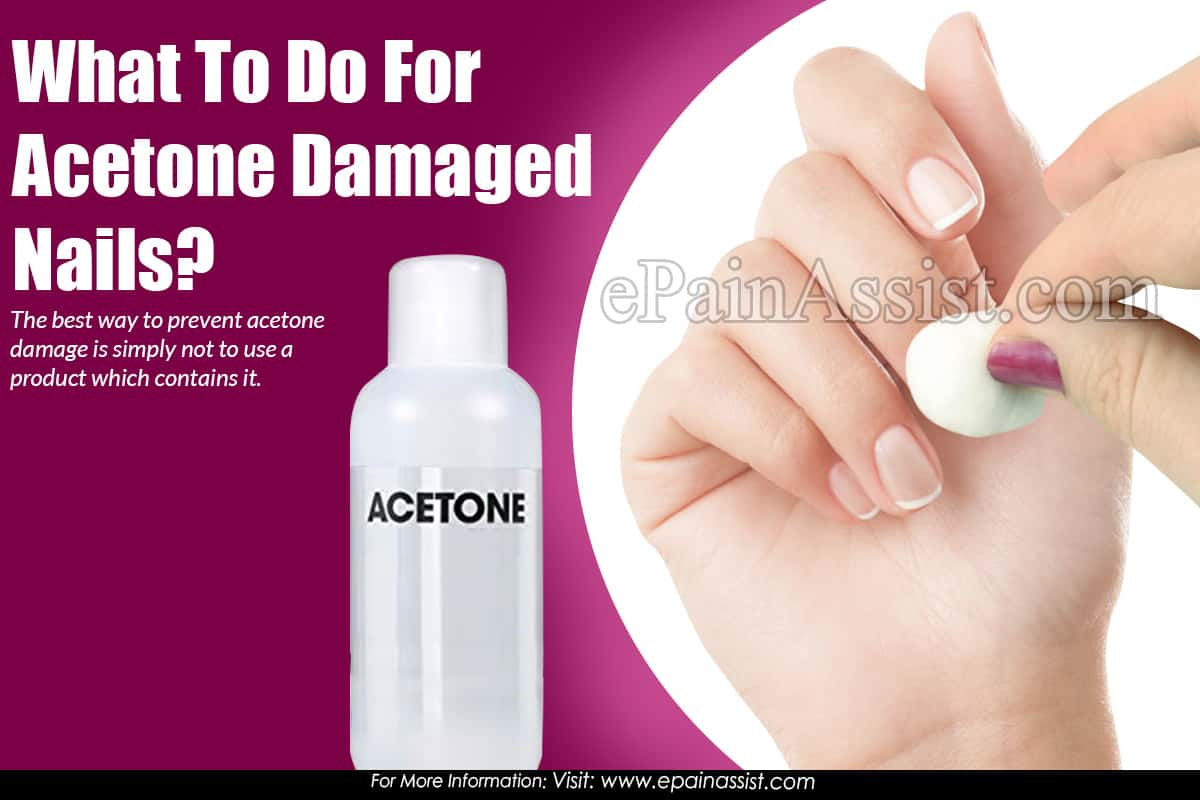Well painted nails definitely look beautiful, but beauty comes with a price. Changing nail polish needs one to use nail polish remover, which most often contains acetone. Acetone is a powerful chemical which not only dissolves nail polish fast, but is strong enough to even dissolve substances like paints, varnishes, glues, waxes, and plastics. The strong solvents in Acetone-based nail polish removers can strip away the natural oils in the fingernails and make them dry and brittle. Acetone also irritates the skin around cuticles and nails. Are you worried because you have acetone damaged nails? Just relax. Fortunately, the damage can be repaired with a little tender care.

What To Do For Acetone Damaged Nails?
Listed below are some effective ways to repair the damage done by acetone to the nails.
Use Acetone-Free Nail Polish Removers: The best way to prevent acetone damage is simply not to use a product which contains it. Only acetone-free nail polish removers should be used. Staying away from acetone-based nail polish removers can help to prevent nail dryness. Acetone-free nail polish removers are easily available at drug stores and their use helps you prevent damage to the nails from acetone.
Use Peel-Off Nail Polish: People should consider using only peel-off nail polish. These nail polishes come off without the application of acetone or other nail polish remover. After applying peel-off polish, a top layer should be added to the usual topcoat to prevent premature peeling of the polish. When one wishes to remove the polish, they can peel it off easily in strips and hence easily prevent acetone related nail damage.
Use Natural Nail Polish: Natural nail polish can be made from the henna herb. Red henna should be properly combined with water in a bowl until it reaches a consistency of a fine paste. This paste should then be applied on the nails using a small paintbrush and allowed to dry for a while before being removed. The stain of henna would remain on the nails until they grow out. Henna is a naturally great method of colouring your nails and avoiding acetone damaged nails in the process.
Apply Cuticle Creams: Cuticle creams are enriched with emollients. Massaging in and around the nails with a cuticle cream rich in natural skin-healing ingredients like vitamin E, aloe vera, and shea butter twice a day can help to recover acetone damaged nails. Another effective natural remedy for this problem is massaging the nails with a mixture of 3 drops each of lavender, rosemary, and lemon essential oil, and 1 ounce of jojoba oil, before bedtime.
Moisturize Your Nails: Acetone mainly causes the problem of dryness. This issue can be managed by moisturizing the nails and wearing white cotton gloves to bed. The nails should be soaked in ¼ to ½ cup of slightly warm olive oil for about 10 to 15 minutes, and then wiped off, but not washed, before putting on cotton gloves. This should be done every night for a month, and then used as a twice-a-month preventive treatment for acetone damaged nails.
Follow a Healthy Diet: By including more of Vitamin A, biotin and calcium in the diet, one can heal their damaged nails more effectively. While B vitamin, or biotin, helps to improve the thickness of brittle nails and decrease splitting, vitamin A aids in healing broken fingernails, and calcium promotes the formation of cartilage for strong bones and nails. However, it is still not clear if oral supplementation of these nutrients can help in the recovery of acetone damaged nails, or not. Following a diet full of healthy nutrients helps you recover faster from acetone damaged nails.
Make use of Rubber Gloves: Wearing rubber gloves when using harsh chemicals or washing dishes, and massaging the hands and nails with a moisturizer after washing them, can help to prevent the nails from getting damaged and dry. Application of a nail-hardener also proves useful in this regard. However, the use of nail hardeners, which containing toluene sulfonamide or formaldehyde, should be avoided as these chemicals can cause skin redness and irritation.
Also Read:
- Onychogryphosis or Ram’s Horn Nails: Causes, Signs, Symptoms, Treatment, Prevention
- Beau’s Lines or Horizontal Ridges on Nails
- Ridges on Nails: What do the Vertical Lines on Nails Suggest?
- Home and Natural Remedies for Nail Pitting or Pitted Nails
- What Can Cause Nail Pitting or Pitted Nails?
- Peeling Finger Nails: What Causes Your Nails to Peel and How to fix it
- Causes of Splitting and Peeling Nails & Natural Ways to Heal it
- Home Remedies to Grow Nails Faster and Stronger Naturally
- 10 Causes of Thick Toenails & 11 Home Remedies To Get Rid Of it
